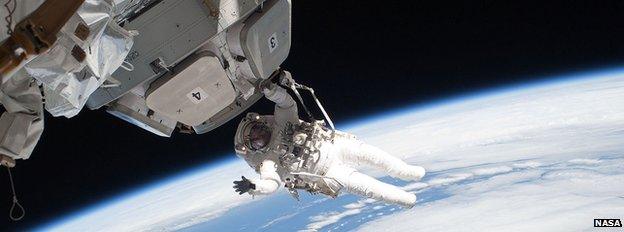'UK spaceman' Nicholas Patrick honoured
- Published

Nicholas Patrick has now completed 18 hours spacewalking outside the station
Nasa astronaut Nicholas Patrick has accepted a British Interplanetary Society pin to mark his achievements.
The silver lapel badge is being given to all UK-born spacefarers who get to orbit the Earth.
Dr Patrick, who hails from Yorkshire but who is now a US citizen, has flown on two shuttle missions.
His most recent trip was on the Endeavour orbiter in 2010, when he helped fit the huge cupola bay window to the underside of the space station.
"It's a great honour and the British Interplanetary Society has been very kind to honour those of us who've been lucky enough to fly," he told BBC News.
"I have to say a major factor in me becoming a British-born, US astronaut was a good slice of luck. I had the right interests of course, but I was also fortunate to be in the right place at the right time."
The spaceman was born in Saltburn-by-the-Sea and completed much of his education in England (Harrow and Cambridge University) before moving to the US, where he did a PhD at the Massachusetts Institute of Technology (MIT).
He later worked for Boeing, integrating new instrumentation into the manufacturer's then latest model - the 777. It was those skills that brought him to the attention of Nasa and he was accepted into the astronaut corps in 1998.
Dr Patrick's first mission was as the robotic arm operator on STS-116 - a mission of the Discovery shuttle in 2006 to continue the construction of the International Space Station (ISS). Using the arm, the astronaut lifted the platform's fifth truss, or backbone, segment into place.
His Endeavour (STA-130) exploits last year were arguably even more exciting, conducting three spacewalks on the exterior of the ISS.
Dr Patrick still hopes to fly again, but opportunities are currently constrained following the retirement of the shuttle. Whereas the orbiter could carry seven people at a time into orbit, the Russian Soyuz capsules being used at the moment will only ferry three individuals per flight.
The "world's highest-flying Yorkshireman" is busying his time instead assisting the programme to develop America's next-generation spaceship, which is called Orion. This conical capsule will take astronauts much deeper into space, beyond the station to destinations such as asteroids, the Moon and even Mars.

The pin recognises an elite group of people but also stands for the promotion of human spaceflight
"I am happy to see the shuttle's gone in one sense because what will replace it will give us much more interersting capabilities, but I'm also very sad to see it gone because it is the most beautiful spaceship that has ever been built," he said.
The British Interplanetary Society has commissioned 10 silver pins, and Dr Patrick is the fourth person to receive one after Helen Sharman, Richard Garriott and Piers Sellers.
The pins are awarded to both recognise the achievements of some extraordinary people, but also to promote human spaceflight in the UK.
Successive British governments have not funded any astronaut activities, and so the only Britons to get into space so far have done so by becoming US citizens and joining the American space agency, or by getting on a private programme of some kind.
Even Tim Peake, who was recently accepted into the European Space Agency's (Esa) astronaut corps, carries no direct British funding behind him. Human spaceflight is an optional programme for Esa member states, and so far the UK has declined to invest in it.
The next recipient of the BIS pin is most likely to be Nasa's Michael Foale, one of the most experienced astronauts in history. Dr Foale, who was born in Louth, Lincolnshire, has logged over 374 days in orbit.
- Published8 December 2010
- Published22 November 2010